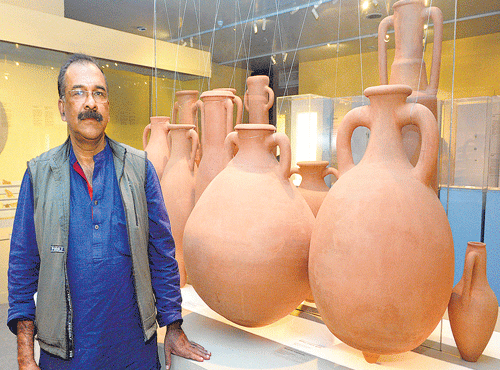
Indirect evidence available on use of Indian stone tools in west
“In medieval times when the ship’s engine whistled to announce its arrival at the port, priests and doctors used to run away and hide lest the sailors caught hold of them.
Back after spending several days at sea, the sailors needed peace which was possible to attain only through these spiritual and medical practitioners,” says Dr PJ Cherian. Known for his expertise in excavations, Cherian is in New Delhi to showcase objects that have been excavated at the archaeological site of Pattanam in Kerala.
The exhibition “Unearthing Pattanam: Histories, Culture, Crossings”, organised by the Kerala Council of Historical Research, has on display articles that provide a glimpse of research on the existence of Muziris, which was a flourishing port city on the Kerala coast and the centre of global spice trade more than 2,000 years ago before it disappeared mysteriously in the 14th century.
A visitor at the exhibition might not be too impressed with the size of the exhibits, since most of them are quite small. Be it gems, stone inlays, glass intaglios, metal pieces or architectural relics, almost each piece requires a magnifying glass to be appreciated.
For instance “The Fortuna Intaglio” is a mere fragment of a carnelian (translucent red or orange quartz) glass measuring 1.5 x 1.0 cm. A look at its huge 200 kg wooden plank (replica) hung on the wall behind it and one realises the worth of this miniature wonder!
This thin, slightly convex piece has a human figure etched vertically on one of its sides. The human figure inscribed on it with striking perfection is of the Greek Goddess Tyche or the Roman goddess Fortuna (goddess of fortune and personification of luck) and can be dated to the early century CE.
Thus these small wonders have helped the researchers delve into the “maritime history of the Indian subcontinent,” says Cherian, the curator of the show. “We had some 1.29 lakh objects but brought only 700 here. Bringing them to Delhi was important,” he said.
For a city dweller, it is difficult to appreciate the significance of a recreated trench, but the same would be of immense attraction to those from the coastal regions. “One important aspect of organising this exhibition is to explain to common people how scientific activities or excavations are capable of telling our past. The material findings tells us what era they belong to,” says the curator.
A proof of this is a display of the huge terracotta pots – “amphorae” (ancient jars with two handles and a narrow neck). Made in nine locations of the Mediterranean, the clay for these amphorae could have been from Turkey, Greece, Egypt, Spain and Italy.
Even the shape of these artefacts throws light to the long lost maritime contacts of India with the other civilisations. The DNA tests of 12 bones of Tamils from South Asia found in Eastern Mediterranean and Europe were a huge discovery in showing clear indications of Indians having traveled Westward long ago than what is known.
In fact, objects excavated at Pattanam prove that foreigners had come to India 15 centuries before Vasco da Gama landed here!
Historical possibilities
Once these historical possibilities are crosschecked, the research from the excavations done at Pattanam is capable of changing the present historical facts that are learnt by rote by children. No wonder, the Pattanam excavations have attracted international attention with the Oxford University sending two of its teachers from the School of Archaeology this year to participate in the fieldwork in Kerala.
Cherian, who has been awarded a visiting fellowship by Oxford University in recognition of his multi-disciplinary archaeological research at
Pattanam, reveals that “The findings at the contemporary sites in Pattanam prove that Indians did go to the West about 2,000 years ago and established their connections in Egypt, South Arabia (historical region) and Europe.
But, we only talk about how the West influenced us and not how we influenced the West.” His voice becomes sullen considering the influence of the Westerners on Indians.
“If we look at the evidences from Alexandria, one can see how Indian spices influenced the West. Probably, it was during this time that India’s Ayurvedic medical traditions and India’s literary traditions also travelled to other parts of the world,” says the curator, mentioning about the export of pepper and cardamom from the Southern ports of India.
“There is indirect evidence that a lot of stone tools and materials from India might have been used for grinding spices in the West, but there is no written literature on this.” There was, however, a liking for Eastern goods among the inhabitants in the West which enabled the movement of cultural elements alongside the edible materials.
As a step from the past to the future, the exhibition integrates art themed on these excavated artefacts in the exhibition. Categorising this as another segment of the excavations and the exhibition, Cherian says that they invited artists to show “How contemporary art engages with pre-historic times.”
Video installations and contemporary art on the excavations are, therefore, an important aspect to explore when visiting the gallery. While one of these videos explains the entire excavation process, there are others which transform this procedure into an art form.
The installation “Black Gold” is one among these. Created by artist Vivan Sundaram, the artwork makes use of body sherds (discarded fragments of pottery).
“We got 4.5 million body sherds during our excavations and gave 80,000 small sherds to Vivan. The video here shows the installation that he has made with these sherds, on the beautiful port city of Muziris, showing how it got flooded in the past,”
explains Cherian.
“Unearthing Pattanam” is ongoing at the
National Museum, New Delhi till January 10.